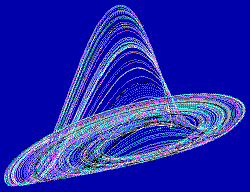Speedy Chaos Control

“Chaos” and “control” may seem as incompatible as the two rival spy agencies with those names on the old TV show “Get Smart.” But a chaotic system can be forced into simple periodic behavior: An electronic circuit whose output voltage varies unpredictably, for example, will become periodic when faced with a series of carefully timed voltage pulses. The 13 September PRL describes a chaos controlling system that works much faster than previous systems. It may be fast enough to control the chaotic patterns that can plague diode lasers used in communications equipment and many other devices.
Diode lasers are found in CD players and grocery scanners, as well as advanced fiber-optic-based communications equipment. A small amount of light reflecting back into one of these lasers can send it into chaotic fits, creating a signal whose intensity fluctuates wildly at frequencies greater than 1 GHz. To fight this problem, Krishna Myneni, of Science Applications International Corporation in Huntsville, AL, and his colleagues wanted a high-speed chaos control system.
Chaotic systems are often described using phase-space plots. To follow a circuit having two voltage outputs, for example, one output is plotted versus the other, so that the simplest periodic behavior in time traces out a closed loop in phase space: The system’s state moves around the loop once per cycle, always retracing the same path. But a chaotic system constantly changes its route, so each time around it takes a slightly different path, eventually filling in a “band” of possible routes.
In 1990 it was shown (Phys. Rev. Lett. 64, 1196) that chaotic systems are capable of periodic orbits in phase space, but fluctuations constantly bump them off track. The paper provided a recipe for intervention that would counter these fluctuations and keep the system on a periodic orbit. For a chaotic circuit, the solution is to apply a voltage pulse during each cycle, with an amplitude that depends on the details of the chaotic behavior. Calculating that amplitude, however, takes some computer crunching, so other researchers developed simpler chaos control techniques that work faster.
Myneni says the chaos control system he and his colleagues developed is simpler and faster than any other, capable of working at 200 MHz in its current form, more than 100 times faster than previous systems. The team’s algorithm is to apply a constant voltage whenever the state of the chaotic circuit is inside of a small, predetermined rectangular “window” in phase space. The window and voltage value are carefully chosen so that on each cycle the pulse pushes the system’s state a bit closer to the corner of the window which is closest to the center of the orbits. This corner is chosen to coincide with a periodic orbit, and on each successive round, the state moves closer to that corner and spends less time crossing the window, which reduces the duration of the pulse.
They demonstrated control on two chaotic circuits–a 1 kHz circuit and a 19 MHz circuit, the fastest chaotic system they could find, short of the very fast realm of laser chaos. Earle Hunt of Ohio University in Athens says the new control system could probably work at 1 GHz or faster, once the team upgrades to more sophisticated electronic components. That would be fast enough to handle laser chaos, according to Myneni. William Ditto of the Georgia Institute of Technology in Atlanta says chaos could also be put to positive uses once it’s controlled at high speeds: “[This work] opens the floodgates for designing high speed optical, communications, and electronics systems that exploit the many natural periodicities in chaotic systems.”


